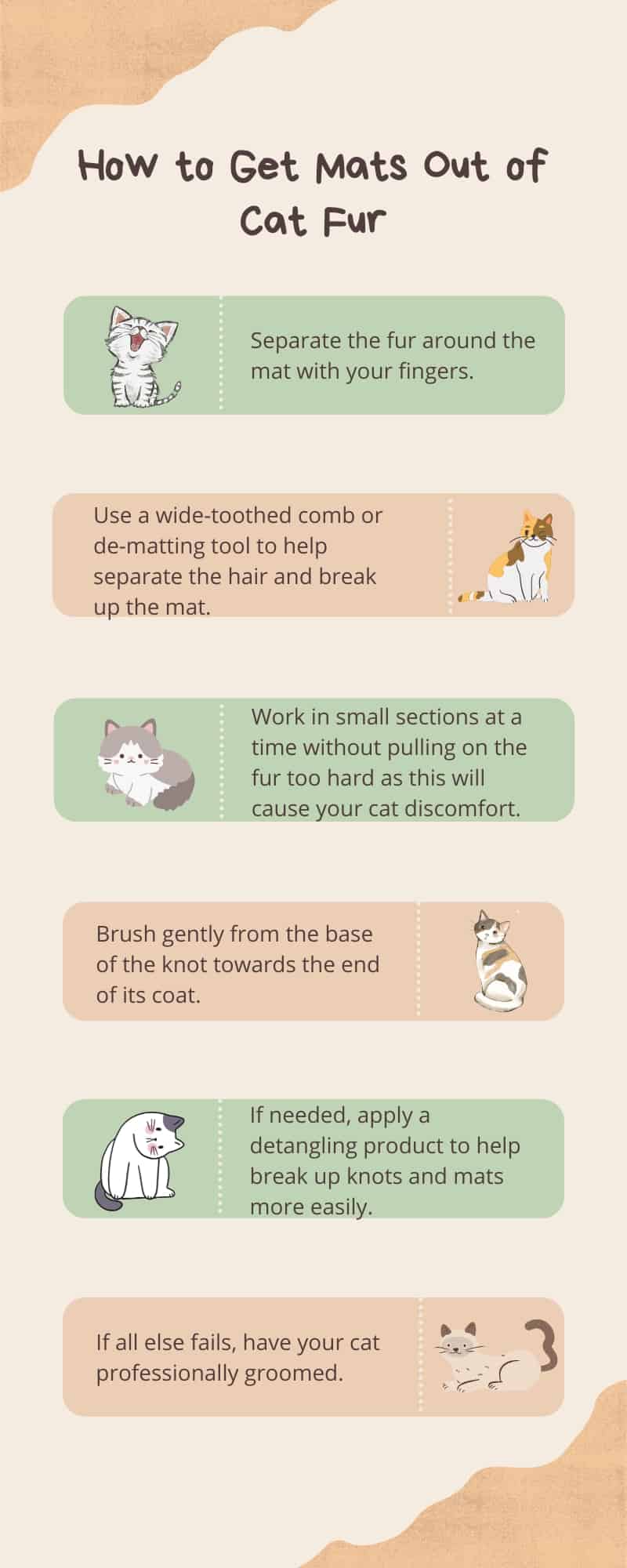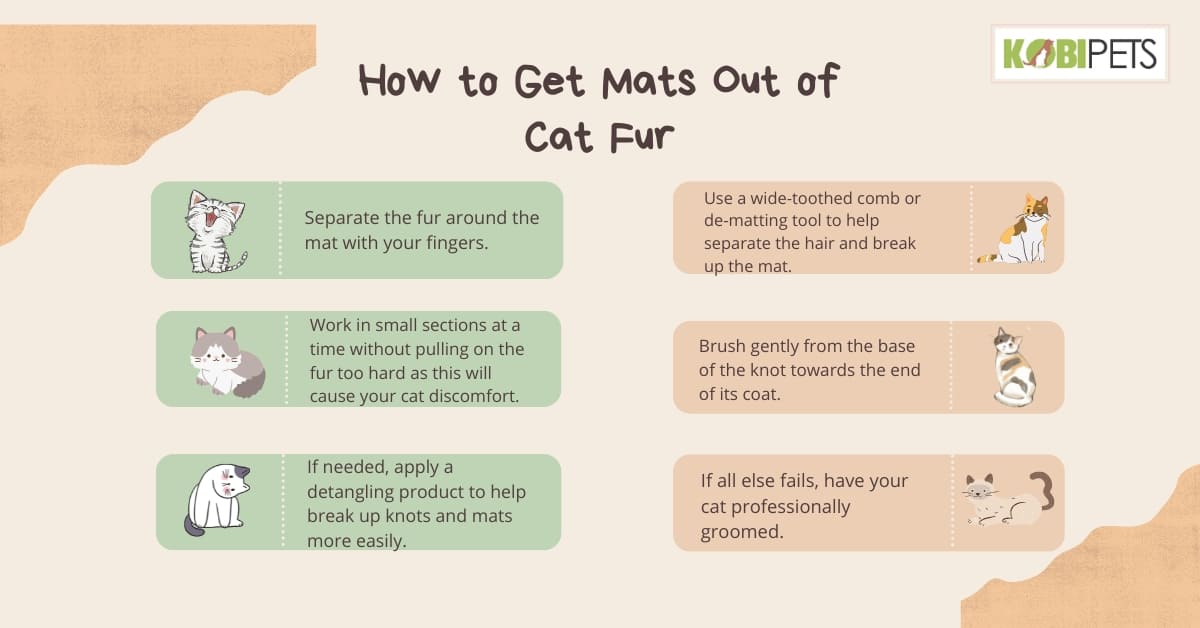
The best way to painlessly get mats out of your cat’s fur is by using a specialized comb or brush. Start by separating the fur around the mat with your fingers and gently untangle it from the base of the knot. Use a wide-toothed comb or a de-matting tool designed specifically for cats to help separate the hair and break up the mat.
Work in small sections at a time, making sure not to pull on the fur too hard as this will cause your cat discomfort. Brush gently from the base of the knot towards the end of its coat, and eventually, you should be able to free any tangles or knots without causing them pain.
How to Get Mats Out of Cat Fur
Mats in cat fur can be a challenge to remove, but there are steps you can take to tackle the issue painlessly and effectively. Gently separating the fur around the mat with your fingers is usually a good place to start, followed by using either a wide-toothed comb or specialized de-matting tools designed for cats.
Here are 6 easy steps on how to painlessly get mats out of your cat’s fur:
Step 1: Separate the fur around the mat with your fingers.
Step 2: Use a wide-toothed comb or de-matting tool to help separate the hair and break up the mat.
Step 3: Work in small sections at a time without pulling on the fur too hard as this will cause your cat discomfort.
Step 4: Brush gently from the base of the knot towards the end of its coat.
Step 5: If needed, apply a detangling product to help break up knots and mats more easily.
Step 6: If all else fails, have your cat professionally groomed.
What is a Matted Fur in Cats?
Matted fur in cats is a common problem and can be easily identified by tight knots of fur that can form around the neck, shoulders, and hindquarters. The causes of this vary and can include long-haired cats being groomed insufficiently, poor nutrition, excessive shedding, or skin diseases.
A matted coat should be taken seriously as it can lead to skin irritation and infections if left untreated. Fortunately, there are ways owners can take action such as regular brushing, using an appropriate shampoo for their cat’s coat type, and frequently checking for any mats or tangles.
If a detangling product isn’t able to work its magic then the safest solution might be to get your cat professionally groomed. When done properly grooming can not just decrease the risk of mats but will also help your cat look beautiful.
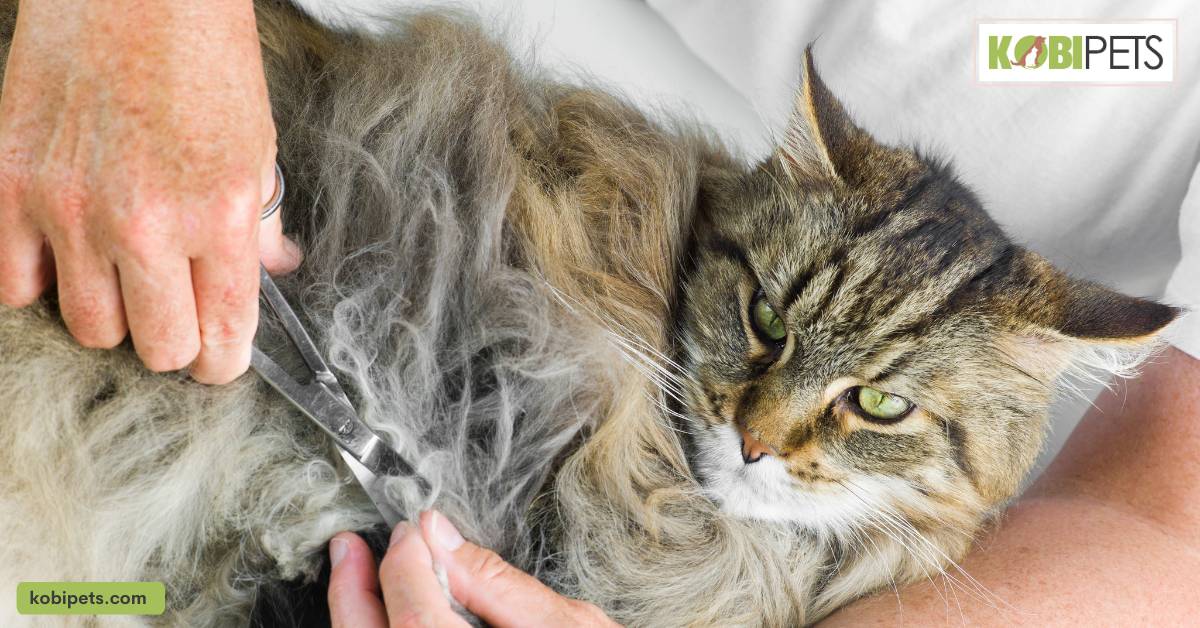
Causes of Matted Cat Fur
Matted fur is an uncomfortable and difficult condition to deal with in cats, and can be caused by a variety of factors. Regular grooming and brushing are the best ways to prevent matted fur since brushing removes loose hair and distributes natural oils more evenly around the cat’s coat.
- Poor nutrition or dehydration can also contribute to matting, as nutritional deficiencies make a cat’s coat brittle and more susceptible to tangles. If your cat has allergies it could be causing them too much itching, leading them to over-groom and causing the fur to matt.
- Environmental conditions may also play a role if your pet has access to an environment with excessive dust or debris that settles into the coat.
- Finally, old age can bring about physical changes both on the skin and in the coat texture that make matting more likely.
Understanding what’s behind a matting issue is key in helping you determine how best to manage it.
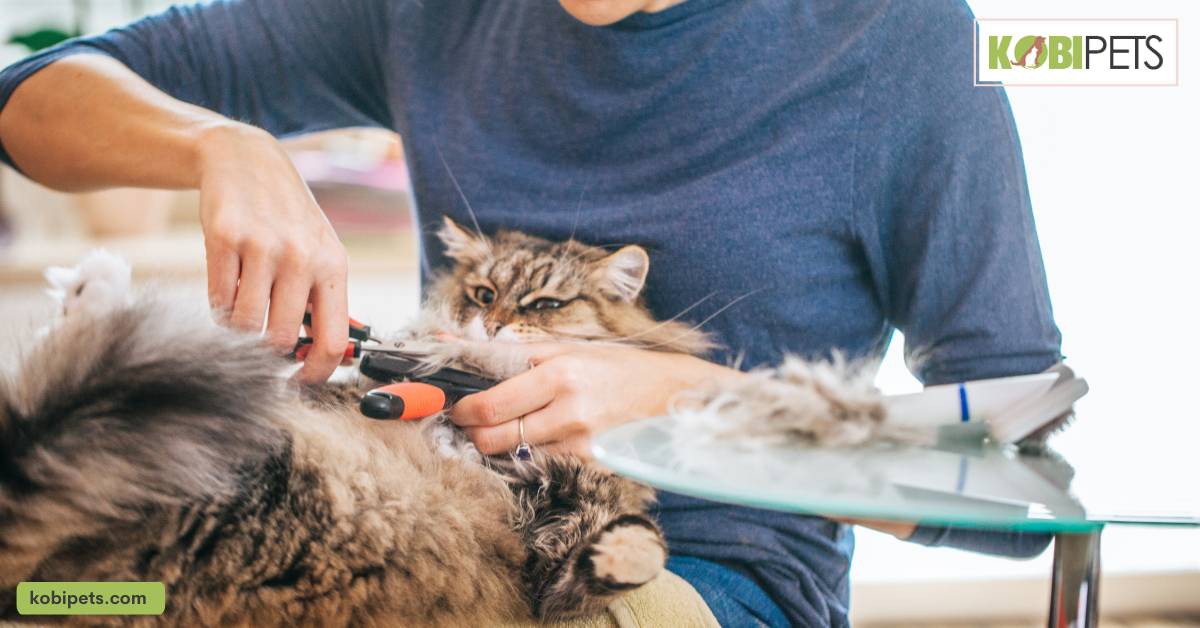
List of Commonly Found Areas with Mats
Mats in cats are a common problem that can be identified by tight knots of fur found around the neck, shoulders, and hindquarters. The causes of matting vary from inadequate grooming to skin diseases, and it can lead to further problems like skin irritation and infections if not addressed quickly.
Commonly found areas of mats in a cat’s fur:
- Neck
- Shoulders
- Hindquarters
- Belly
- Underarms
- Behind the ears and head
- Between the toes and pads of each foot
- Legs and tail area
How to Prevent Matted Cat Fur
write three sentences on How to Prevent Matted Cat Fur as an introduction
Preventing matted fur in cats is key to keeping them healthy and happy. Regular grooming, proper nutrition, and environmental considerations are all important steps owners can take to reduce the risk of mats forming in their cat’s coats. Finally, if you have an elderly or long-haired cat it may be best to consider professional grooming on a regular basis.
Regular Grooming
Having a well-groomed cat is essential for their overall health and well-being. To keep cats from developing matted fur, you should brush them regularly. In short-haired breeds, brushing once a week is usually sufficient but other breeds may need to be groomed several times each week.
Regular grooming helps to remove any self-bathing-caused mats, remove dead hair and skin cells, prevent parasites such as fleas, and stimulate circulation bringing essential nutrients to the skin and fur. Additionally, it helps distribute natural oils across their coat which keeps it looking shiny and vibrant.
If your cat is prone to matting you can also use regular baths in conjunction with brushing or switch out a normal metal comb for one specially designed for tangled fur before starting. Although taking proper care of grooming can be time-consuming it pays dividends in the long run and provides opportunities to build closer relationships with your cat.
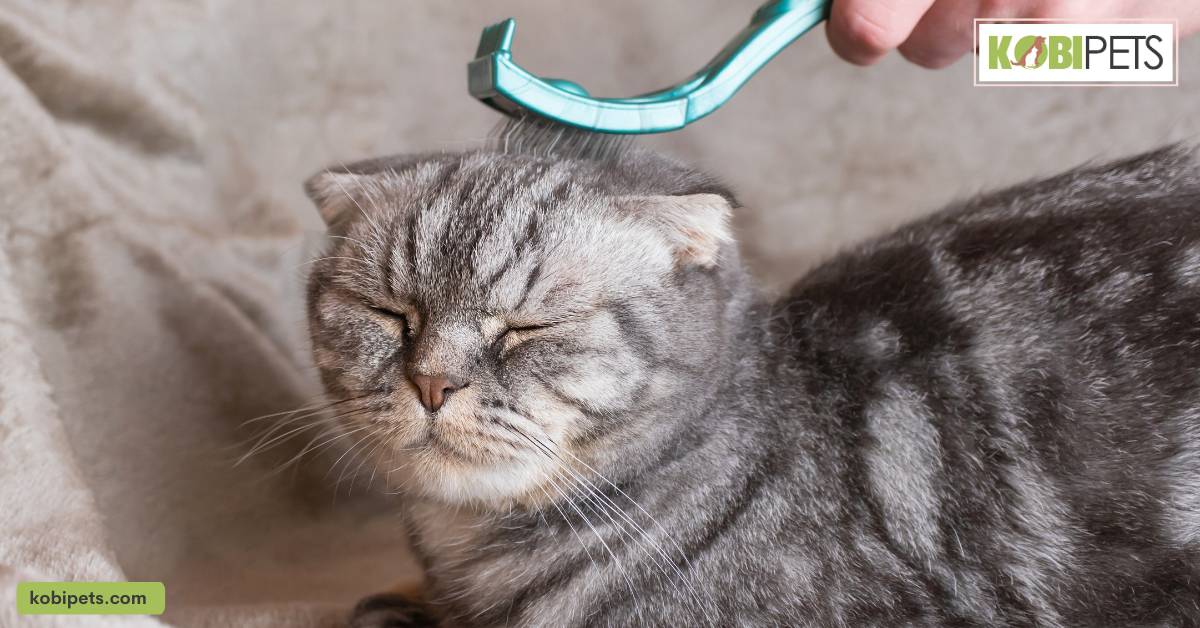
Proper Nutrition
Proper nutrition is key to keeping your cat’s fur healthy and avoiding mats. A diet rich in protein and omega-3 fatty acids will help keep their coat shiny and strong. Make sure to avoid foods that are high in carbohydrates, as this can lead to weight gain and fur that is more prone to matting.
Giving your cat plenty of opportunities to groom themselves is also important – provide them with a scratching post or brush to help remove loose hair and prevent mats from forming in the first place.
Environmental Considerations
Taking environmental considerations into account when preventing matted cat fur is essential for using the most sustainable solutions. Brushing is a preferred method over bathing, as baths can stress cats and require the use of water, soap, and potential irritation in their eyes, ears, and noses.
Keeping your pet’s coat healthy with regular brushing can reduce the need to bathe them altogether. As an added benefit of this process, you may even see your cat has lessened or no mats at all. If you do find tangles or mats on your pet’s coat, groomers suggest using tools that work with their locks rather than pulling them apart – avoid scissors, metal combs, or intricate tools – all of which are considered unsafe for cats.
Not only will these practices have your kitty looking great, but they present an opportunity to bond with their human while creating a more eco-friendly routine.
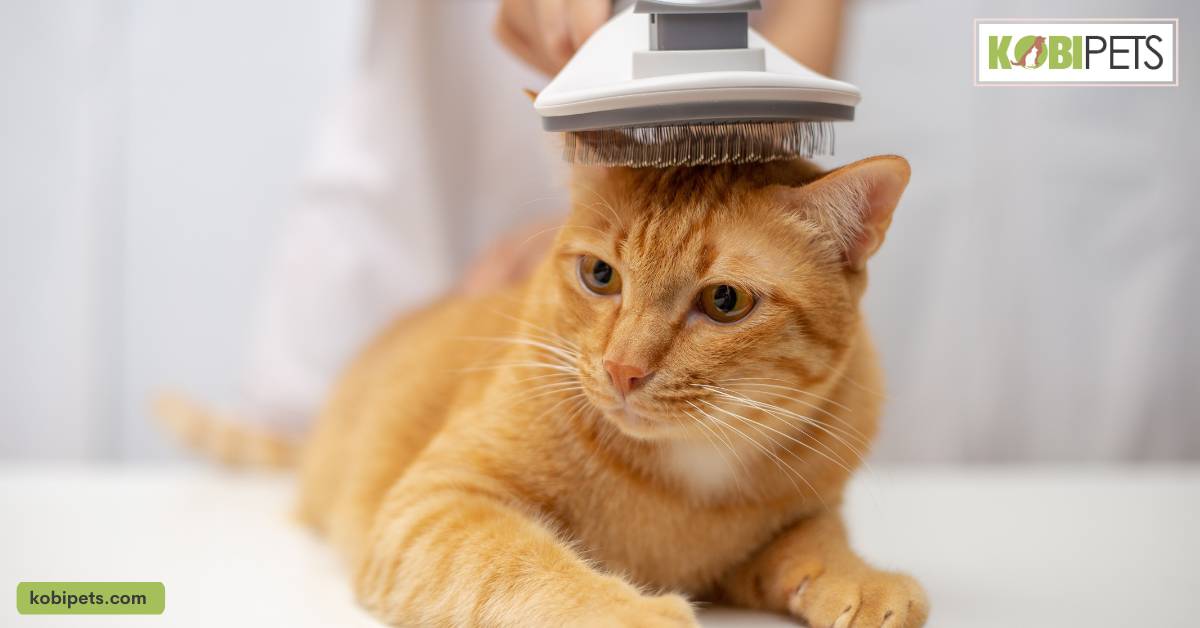
Suitable Shampoo
There are preventative measures you can take when choosing a suitable shampoo that is specifically designed to prevent matted cat fur. Look for ingredients like natural oils, which help keep your cat’s fur conditioned; oatmeal, which is known to be soothing, and aloe vera, which provides extra nourishment.
When bathing your pet, use warm water and apply the shampoo in a gentle lather being careful not to get any in their eyes. Rinse thoroughly with warm water until all the suds are gone before drying with a towel or blow dryer on low heat setting.
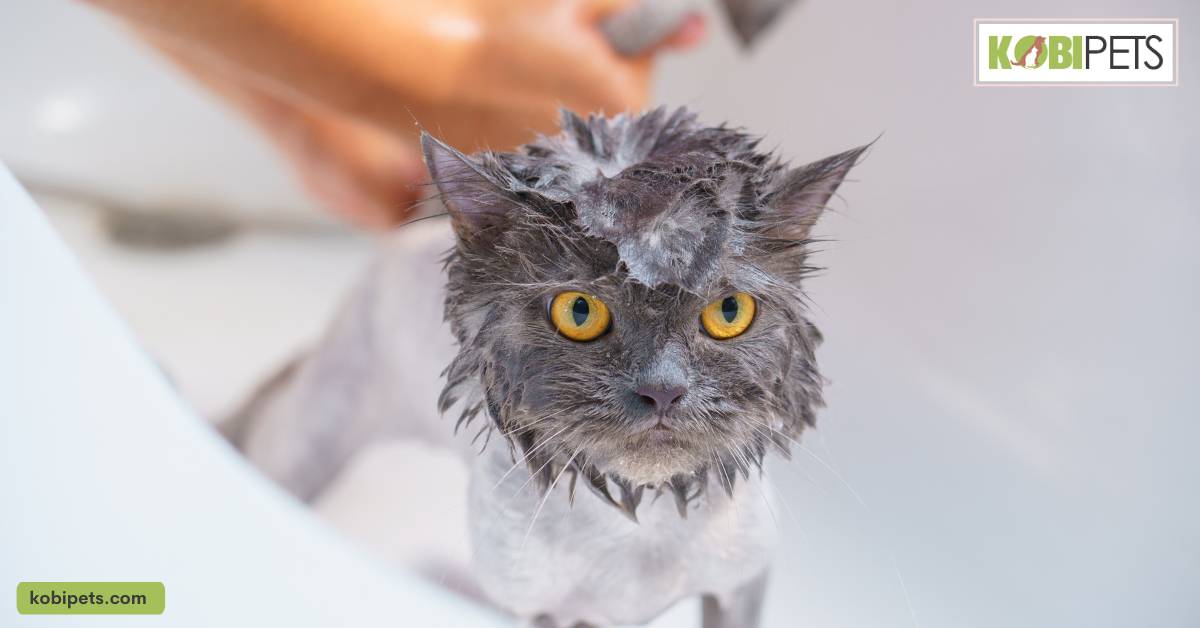
Regular Checking
To prevent matted cat fur from forming, it is important to brush your pet at least twice a week, especially during shedding season. Additionally, make sure you use a specialized brush for cats with long hair in order to properly capture loose hairs before they have a chance to get matted.
Routine professional grooming can also help maintain a clean and healthy coat without any dreaded mats. Regularly scheduled visits will remove any existing mats, excessive fur, and debris from the fur while providing stimulation through gentle massages and soothing brushing motions.
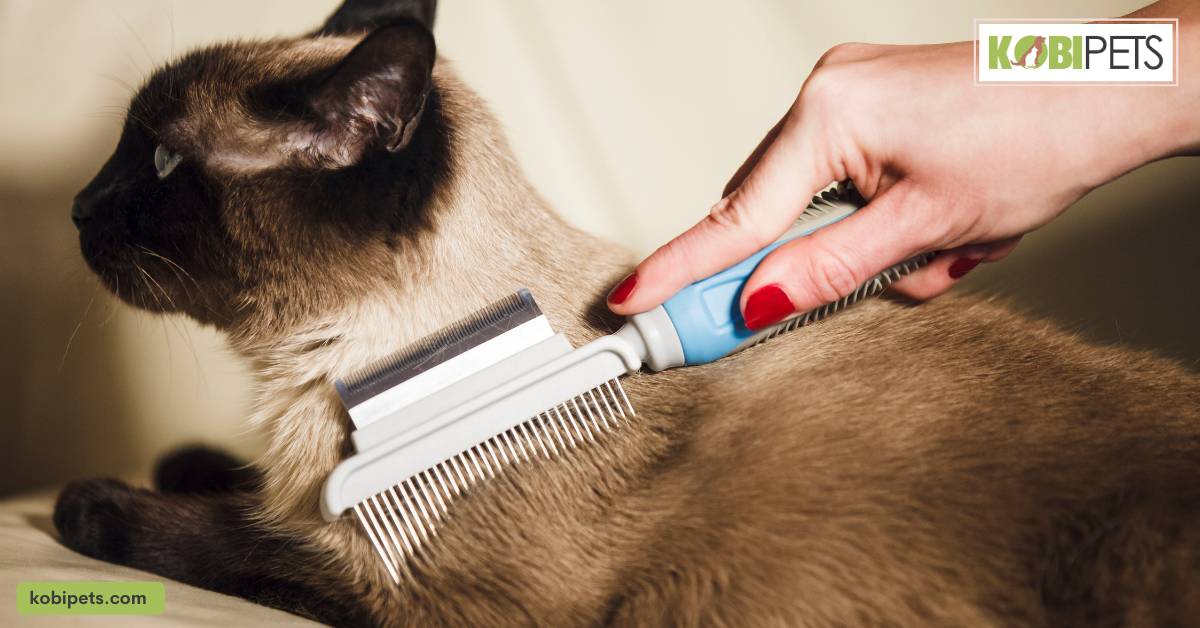
Additional Tips for Painless Mat Removal
Be Gentle When Brushing Your Cat’s Fur
Cats, even those who love being groomed, have sensitive skin that can be easily irritated by too much brushing. So if you are trying to tackle a particularly nasty mat in your feline friend’s fur, start off with a brush at the top of the mat away from the cat’s skin.
This will loosen the knot gently and give you easier access for more effective de-matting further down. Remember to also be careful not to break through any knots too quickly – going too fast or using extra pressure could cause your cat pain and result in long-term avoidance of brushing altogether.
The key is patience: slow and steady wins the race when it comes to mat removal with minimal discomfort or distress for your kitty!
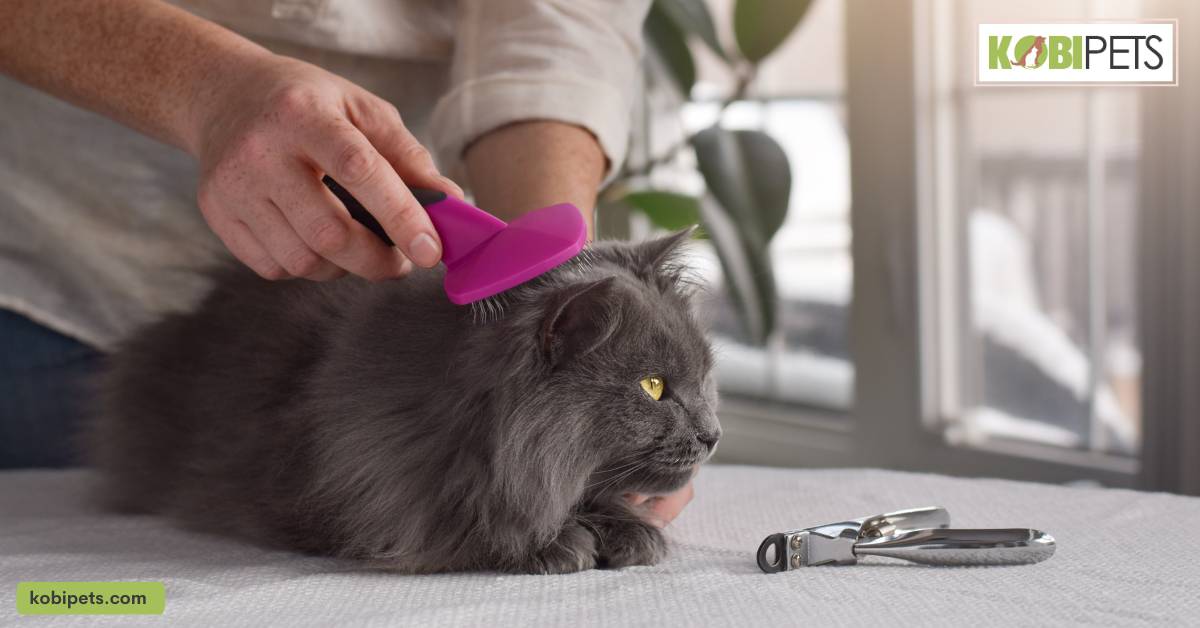
Work in Sections
Removing stubborn mats can be a tricky and time-consuming process. However, with the right tips and tricks you can make this task much easier and less painful for your cat! The key is to work in sections.
Use scissors or clippers to carefully snip away at small sections of the mat while being cautious not to cut the animal’s skin. You can also use a comb to loosen up tangled fur before cutting or try using a conditioning spray first and then brush through lightly for easier removal.
Make sure you reward your cat after each successful section is removed as this will increase motivation during the mat removal process.
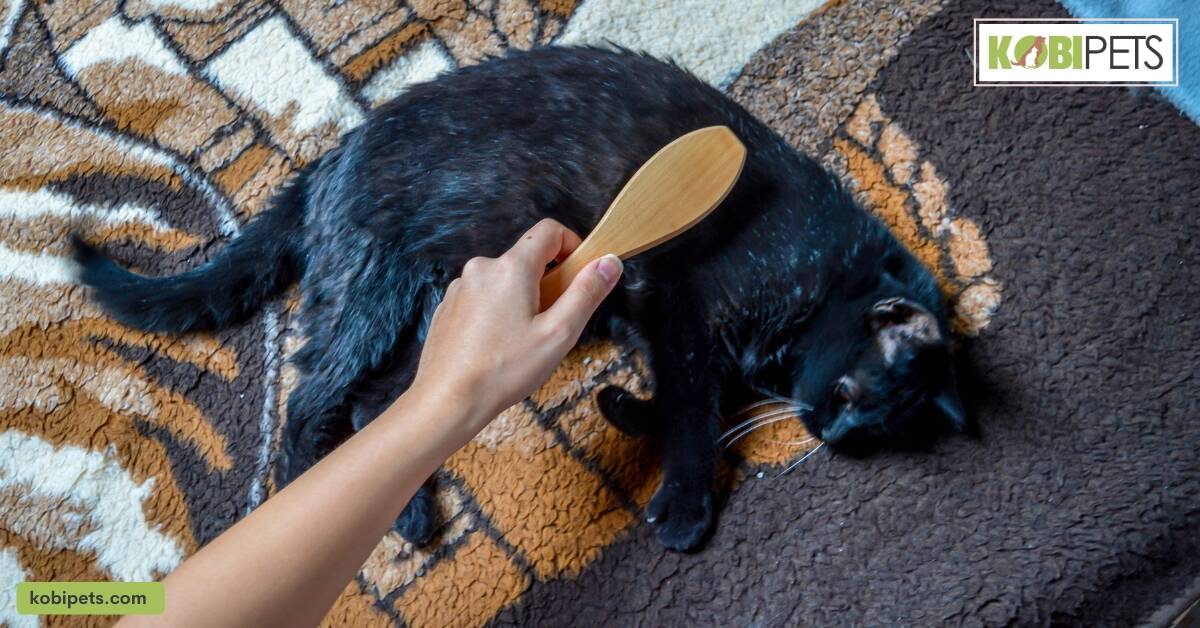
Give Your Cat Breaks
Giving your cat breaks when attempting to remove mats from its fur is one of the best ways to do it without inflicting pain. Cats are sensitive animals, and doing too much too quickly can have the opposite effect and make them even more skittish.
Start with a gentle brushing session that lasts for no longer than five minutes, provide plenty of positive reinforcement (treats, petting, etc.), and give it a break in between. This will help to gradually desensitize your cat to the brushing motion and make it easier for you both in the long run.
Moreover, using specialized tools such as mat splitters and detangling sprays can also be useful in tackling stubborn knots if they don’t come out with regular brushing. Taking these measures can help ensure that you won’t be causing any unnecessary discomfort when removing mats from your pet’s fur.
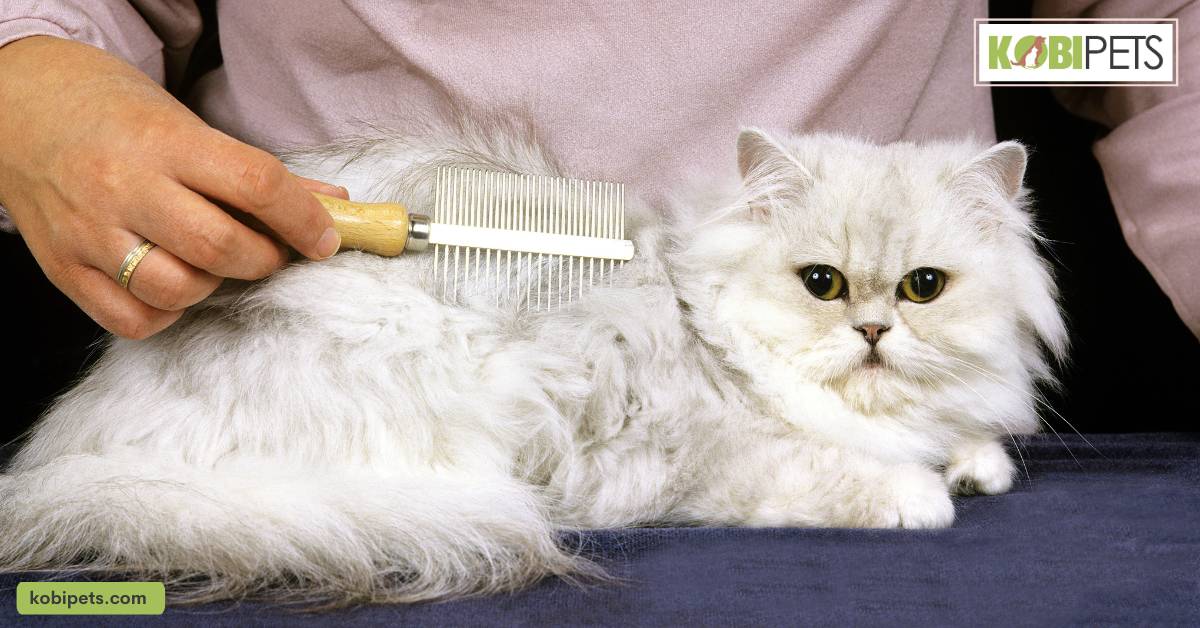
Look for Skin Irritations or Discomfort
If you want to ensure a painless cat fur mat removal process, always begin by looking for any signs of skin discomfort or sores. If you spot anything like this, cease the grooming process and go to your vet as soon as possible.
Not only will they be able to examine the situation and provide medical treatment if necessary, but they can also give you tips on how to prevent similar future occurrences through proper maintenance techniques.
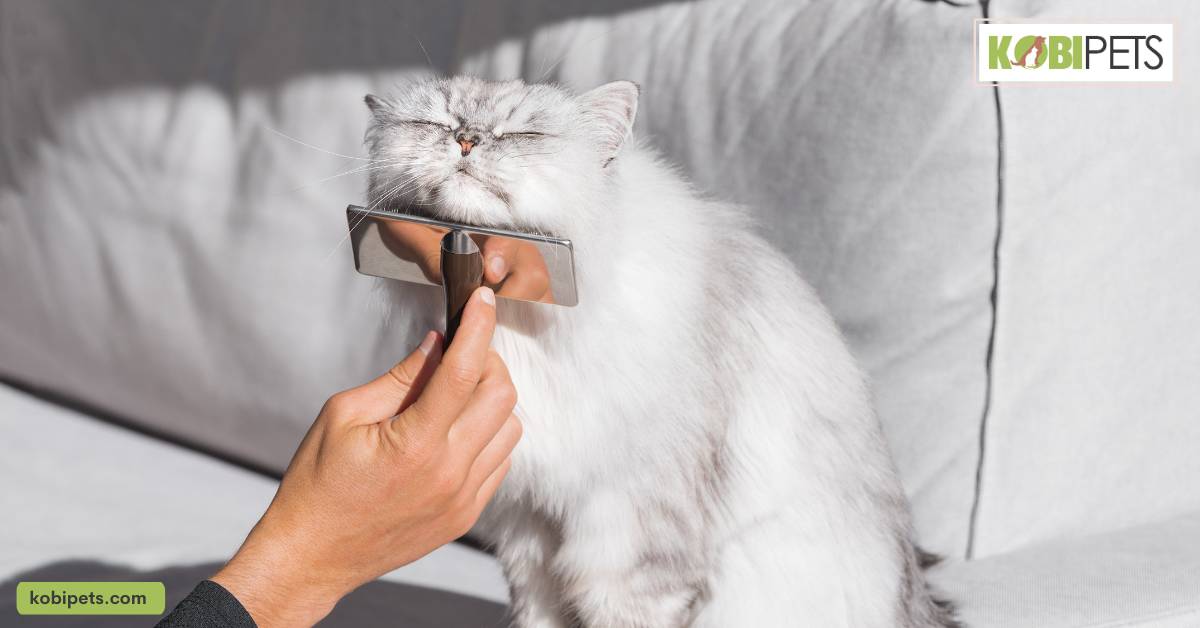
When Should I Take My Matted Cat to the Groomer?
When it comes to the health and well-being of your cat, maintaining their healthy coat is an important factor. It is recommended by most veterinarians that you bring your matted cat to the groomer at least every eight weeks to ensure tangles and knots are removed before they become too big.
Don’t be afraid to take them more often if you notice fur piling up faster – extra trips can help prevent extensive matting which can be painful for your pet. Keep in mind that professional groomers will be able to detangle the hair swiftly and safely, saving both you and your cat from a stressful experience.
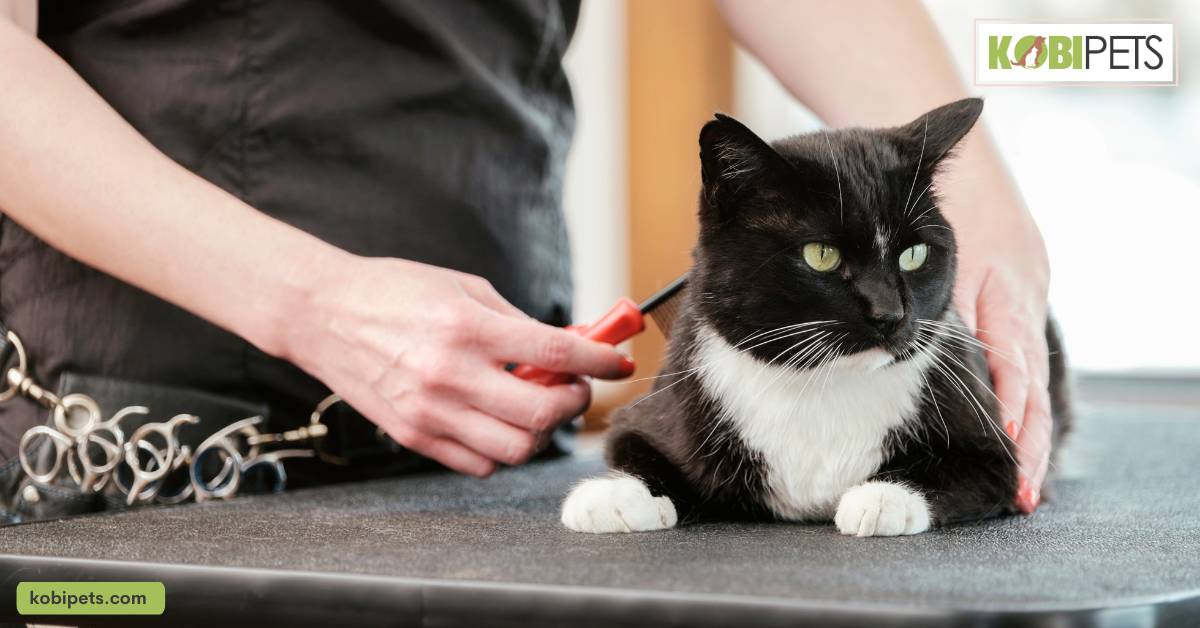
In Conclusion
Maintaining a healthy coat and preventing matted cat fur is an important part of caring for our feline friends. Regular brushing, proper nutrition, environmental considerations, specialized brushes, and suitable shampoos are all key components to keeping their coats in tip-top shape.
Remember to always be gentle when attempting to remove mats as too much pressure or harsh conditions can cause skin irritation and discomfort. If the matting is beyond your skill level, it is best to consult a professional groomer in order to ensure your cat’s coat remains healthy and pain-free.
